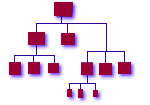


|

|
|
home | sitemap | abstract | introduction | chaos | thinking | checklist | migrating | recovery pushpull | cost | career | workshop | isconf | list_and_community | papers | references |
Infrastructure Thinking
We found that the single most useful thing a would-be
infrastructure architect can do is develop a certain mindset: A
good infrastructure, whether departmental, divisional, or
The enterprise cluster is there to provide a substrate for the enterprise to do its job. If it doesn't do that, then it costs the enterprise unnecessary resources compared to the benefit it provides. This extra cost is often reflected in the attitude the enterprise holds towards its systems administration staff. Providing capable, reliable infrastructures which grant easy access to applications makes users happier and tends to raise the sysadmin's quality of life. See Cost of Ownership . This philosophy overlaps but differs from the "dataless client" philosophy in a subtle but important way: It discourages but does not preclude putting unique data on client hard disks, and provides ways to manage it if you do. See Network File Servers , Client File Access , Client Application Management . The enterprise cluster concept simplifies how we maintain individual hosts. Upon adopting this mindset, it immediately becomes clear that all nodes in an enterprise cluster infrastructure need to be generic, each providing a commodity resource to the infrastructure. It becomes a relatively simple operation to add, delete, or replace any node. See Host Install Tools . Likewise, catastrophic loss of any single node causes trivial impact to users. Catastrophic loss of an entire infrastructure is as easy to recover from as the loss of a single traditionally-maintained machine. See Disaster Recovery . When we log into an enterprise cluster, we expect to use the same userid and password no matter which node we log into. Once authenticated, we should be able to travel with impunity throughout the cluster across other nodes without obstruction. This is true whether those nodes sit on a desktop or in a server room. In practice, this idea can be modified to include the idea of "realms" of security which define who can access certain protected areas of the enterprise-wide cluster. You might want to implement a policy that disallows ordinary user logins on nodes of class "NFS server", for instance. Note that this approach is markedly different from explicitly giving users logins on each individual machine. By classing machines, you ensure that when a new machine is added to a class, the correct users will already be able to log into it. See Authentication Servers . Adds, moves, and changes consume a great deal of time in a traditional infrastructure because people's workstations have to be physically moved when the people move. Computing itself is enabling organizations to become more dynamic -- meaning reorgs are becoming more prevalent. This makes free seating critical in modern infrastructures. In an enterprise-cluster infrastructure made up of commodity nodes, only the people need to move; they log off of their old workstation, walk over to their new desk, sit down, log in, and keep working. They see the same data and binaries, accessed via the same pathnames and directory structure, no matter which node they log into. This is well within the capabilities of modern automounters and NFS, particularly if you are willing to add some Perl glue and symbolic link farms. See Client File Access , Client Application Management . Traditionally, installing an application or patch means visiting each machine physically or over the net to install that package. In an enterprise cluster infrastructure, you "install" the package once by dropping it into a central repository and letting it propagate out from there to all of the hard disks. See File Replication Servers , Client O/S Update . |
|
||||||||
|
© Copyright 1994-2007 Steve
Traugott,
Joel Huddleston,
Joyce Cao Traugott
In partnership with TerraLuna, LLC and CD International |
||||||||